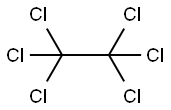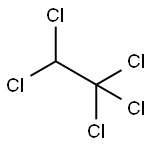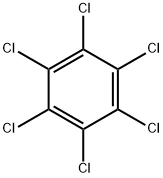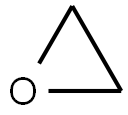Hexachloroethane , StandardforGC,≥99.5%(GC) , 67-72-1
Synonym(s):
Hexachloroethane solution;Perchloroethane
CAS NO.:67-72-1
Empirical Formula: C2Cl6
Molecular Weight: 236.74
MDL number: MFCD00000799
EINECS: 200-666-4
PRODUCT Properties
| Melting point: | 183-185 °C (dec.) (lit.) |
| Boiling point: | 186℃ |
| Density | 2.091 g/mL at 25 °C (lit.) |
| vapor density | 8.16 (vs air) |
| vapor pressure | 0.4 mm Hg ( 20 °C) |
| refractive index | 1.5282 (estimate) |
| Flash point: | 9℃ |
| storage temp. | 2-8°C |
| solubility | Soluble in alcohol, benzene, chloroform, ether |
| form | Crystals or Crystalline Powder |
| color | White |
| Water Solubility | 0.05 g/L (22 ºC) |
| Merck | 14,4679 |
| BRN | 1740341 |
| Henry's Law Constant | 1.43, 2.81, and 5.31 at 10, 20, and 30 °C, respectively (Munz and Roberts, 1987) |
| Exposure limits | TLV-TWA 10 ppm (~100 mg/m3) (ACGIH),
1 ppm (MSHA and OSHA), Lowest Feasi ble Limit (NIOSH); carcinogenicity: Animal
Limited Evidence (IARC). |
| Stability: | Stable. Non-combustible. May react with hot metals, strong oxidizing agents. |
| CAS DataBase Reference | 67-72-1(CAS DataBase Reference) |
| IARC | 2B (Vol. 73) 1999 |
| NIST Chemistry Reference | Ethane, hexachloro-(67-72-1) |
| EPA Substance Registry System | Hexachloroethane (67-72-1) |
Description and Uses
Hexachloroethane (HCE) is a halogenated hydrocarbon consisting
of six chlorines attached to an ethane (ACGIH, 1991); it
is a white to pale yellow solid that is unstable in air and evaporates
gradually. It smells like camphor when its concentration
in air and water are 150 and 10 ppb, respectively. HCE itself
does not catch fire easily; however; in aqueous nonbiological
conditions it has been determined that HCE is unstable and
nonenzymatic dechlorination in the absence of nicotinamide
adenine dinucleotide phosphate (NADP) occurs. It rapidly
degrades in soil or groundwater. Also, some microorganisms
break down HCE without oxygen, and decomposition in
aerobic conditions has been reported. Some bioconcentration
of HCE in fish has been determined, though upper levels
through the food chain are limited, since it is rapidly metabolized
by fish, which is discussed later (ATSDR, 1997).
Eyes, skin, respiratory system, and kidneys have been
proposed as main targets in humans upon exposure. Symptoms
include blinking, tearing, photophobia, and irritation of
eyes. Also, facial muscles may have difficulty in movement.
Animal studies on effects of HCE during pregnancy are limited.
After oral exposure, HCE is primarily distributed to fat tissue.
Toxicokinetic studies in animals indicated that HCE is mostly
localized and metabolized in the liver and kidney. Several
corresponded metabolites have demonstrated liver and kidney
toxicities similar to HCE. Neurological effects such as tremors
and ataxia were observed in Beagle dogs, rats, and pregnant
rats. Other effects via inhalation exposure included reduced
body weight and increased relative liver weight in rats and
guinea pigs. In another study, male rats also displayed
increased relative spleen and testes weight. Based on California
Proposition 65, HCE was proposed to be carcinogenic for
humans, and it induces tumors at sites other than the site of
entry. Noncancerous effects include kidney degeneration
(tubular nephropathy, necrosis of renal tubular epithelium,
hyaline droplet formation, tubular regeneration, and tubular
casts) and hepatocellular necrosis. It results in hyaline droplet
nephropathy and renal toxicity, and it induces chromosome
malsegregation, lethality, and mitotic growth arrest (Crebelli
et al., 1995, 1992, 1988).
Hexachloroethane is used as a solvent, infireworks and smoke devices; in explosives,in celluloid, as an insecticide, and as a rubbervulcanizing accelerator. Earlier it was used asan anthelmintic for livestock. Hexachloroethane is a highly efficient chlorinating agent in the preparation of chlorosilanes from hydrosilanes.
Safety
| Symbol(GHS) |    GHS07,GHS08,GHS09 |
| Signal word | Warning |
| Hazard statements | H319-H351-H410 |
| Precautionary statements | P202-P264-P273-P280-P305+P351+P338-P308+P313 |
| Hazard Codes | Xn,N,T,F |
| Risk Statements | 40-51/53-36/37/38-39/23/24/25-36/38-23/24/25-11-50/53-52/53 |
| Safety Statements | 36/37-61-45-36/37/39-26-24-16-7-37/39 |
| RIDADR | UN 9037 |
| OEB | B |
| OEL | TWA: 1 ppm (10 mg/m3) [skin] (Chloroethanes) |
| WGK Germany | 3 |
| RTECS | KI4025000 |
| TSCA | Yes |
| HazardClass | 9 |
| PackingGroup | III |
| HS Code | 29031990 |
| Hazardous Substances Data | 67-72-1(Hazardous Substances Data) |
| Toxicity | MLD i.v. in dogs: 325 mg/kg (Barsoum, Saad) |
| IDLA | 300 ppm |





